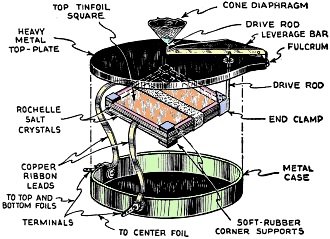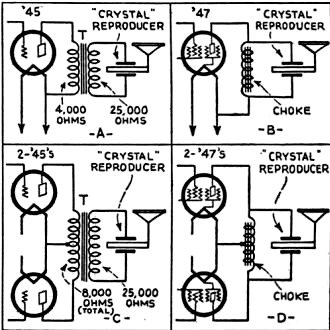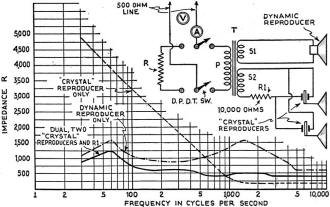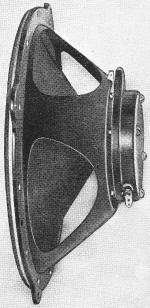|
July 1932 Radio-Craft
 [Table
of Contents] [Table
of Contents]
Wax nostalgic about and learn from the history of early electronics.
See articles from Radio-Craft,
published 1929 - 1953. All copyrights are hereby acknowledged.
|
Potassium sodium tartrate (Rochelle
salt) was used in commercial speakers for a while in place of electromagnetic
driver coils. The relatively large mechanical deformation produced when subject
to an electric field made them attractive as coil alternatives because a separate
energization circuit was not required. The drawback, at least early on, was unavailability
of crystals large enough to drive anything other than a headphone size speaker cone.
This 1932 Radio-Craft magazine article tells of the time when a process
was created to grow large crystals from a seed, similar to how silicon, gallium-arsenide,
and other modern semiconductors are grown from seeds. According to author C.B. Scott,
it revolutionized the speaker industry - at least for a while. I don't know
if a 1930s' lawyer advised companies to place "Do not put in mouth" warning labels
on the speakers since, according to Wikipedia, Rochelle salts were also used as
laxatives.
The Rochelle-Salt Crystal Reproducer

Fig. 1 - The speaker's crystals.
By C. B. Scott*
A revolutionary idea in commercial reproducer design. A Rochelle-Salt Crystal,
of improved construction, mechanically coupled to a cone gives remarkable clarity
and volume. Consuming no power, it has high efficiency.
Piezo electricity, a phenomenon well known to most radio engineers, demonstrable
in quartz and other crystals, is present in much greater quantity in Rochelle-salt
crystals. Until quite recently, however, it had been impossible to obtain these
crystals in size and quantity to make their commercial application practicable.
At last, a process has been developed for growing large, homogeneous crystals, and
methods have been devised for machining and shaping them into usable sizes and shapes.
Direction of Motion
The Type R-95 "Crystal Reproducer," illustrated in Figs. A and B uses a double
or "bimorph" crystal element consisting of two slabs 2 1/2 x 2 1/2 x 1/8-in. thick,
metal-foiled on each surface, and cemented together in opposition to each other
so that a torsional motion of the combined slabs, illustrated in Fig. 1 results;
when three corners of the element are held semi-rigid, the vibration of the fourth
corner is in a direction vertical to the flat surfaces. (This action is similar
to that in thermostats, where the expansion of one metal and contraction of the
other in one [parallel] plane, produces a "wiggling" motion in another. Technical
Editor.)

Fig. B - Picture of the new Crystal speaker which is bound
to be used in all receivers that require a maximum of sensitivity.

Fig. 2 - Vacuum tube speaker driver circuits.

Fig. 3 - Impedance variations.
This corner is fitted with a metal cap provided with a connecting link which
in turn is soldered to a tone arm, providing a mechanical amplification of motion
of 2 1/2 to 1.
The end of the tone-arm is then fastened to the center of a conventional paper
cone and results in a very light, compact reproducer, suitable for general use,
with an outside diameter of 9 1/2 in., a depth overall of 3 3/4, in.; and a weight
of two pounds (as compared with the typical "dynamic" type of reproducer, weighing
approximately 5 1/2 pounds).
The "crystal" reproducer has several advantages from the electrical point of
view.

Fig. A - This speaker was tested by Radio Craft and found
to have excellent tone quality and volume.
It is voltage-operated and the power consumption is very low, as it requires
neither field current nor polarizing voltage. For this reason it has been recognized
as being especially valuable in multiple reproducer work, such as installations
in schools, hotels, and hospitals. Due to its very high "sensitivity," several may
be operated on the same power required to operate one of the present type of reproducers.
Likewise in this type of installation, one of the important factors is that there
be a minimum of service and repair work. "Crystal" reproducers have been operated
for a continuous period of four years under a wide variation in temperature and
humidity change, with no deterioration in output.
Frequency Range
The "crystal" reproducer covers a much wider range of frequencies than is now
covered by the present types of reproducer units. The Rochelle salt crystal itself
is responsive from 0 to 500,000 cycles and when built into a reproducer the only
limiting factor is the method by which the crystal is made to reproduce through
an associated tone-arm, cone, etc., and the frequencies which are brought to it
as a result of broadcast station equipment and radio receiving sets.
The reproducer is considered to have a "negative impedance" (condenser effect)
of about 25,000 ohms at 1,000 cycles, and characteristics similar to those of a
0.03-mf. condenser.
It operates extremely satisfactorily when connected directly across an output
choke in the plate circuit of a type '47 pentode tube. It also has an astonishing
volume when connected across the output inductance in the plate circuit of a pair
of type '30 tubes connected in push pull, and is especially good for battery-operated
sets when operated by a pair of these tubes in "push-push" or class B amplifier
connection. The diagrams shown below indicate the possible hookups with pentode
and '45 tubes either singly or in push-pull.
* Brush Development Co.
Posted August 3, 2023
(updated from original post
on 7/1/2015)
|













